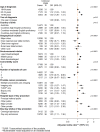Cancer-related hospitalisations and 'unknown' stage prostate cancer: a population-based record linkage study
- PMID: 28077413
- PMCID: PMC5253597
- DOI: 10.1136/bmjopen-2016-014259
Cancer-related hospitalisations and 'unknown' stage prostate cancer: a population-based record linkage study
Abstract
Objectives: To identify reasons for prostate cancer stage being recorded as 'unknown' in Australia's largest population-based cancer registry.
Design: Prospective population-based cohort.
Setting: New South Wales (NSW) is the most populous state in Australia, with almost one third of the total national population.
Participants: NSW Cancer Registry (NSWCR) records for prostate cancer cases diagnosed in 2001-2009 were linked to the NSW Admitted Patient Data Collection (APDC) for 2000-2010. All patients in this study had a minimum of 12 months follow-up in the hospital episode records after their date of diagnosis as recorded by the NSWCR.
Main outcome measures: Incidence of 'unknown' stage prostate cancer and cancer-specific survival.
Results: Of 50 597 prostate cancer cases, 39.9% were recorded as having 'unknown' stage. Up to 4 months after diagnosis, 77.2% of cases without a hospital-reported cancer diagnosis were recorded as having 'unknown' stage. Among those patients with a hospital-reported cancer diagnosis, stage was 'unknown' for 7.6% of cases who received a radical prostatectomy (RP) and for 34.0% of cases who had procedures other than RP. In the latter group, the factors that were related to having 'unknown' stage were living in disadvantaged areas (adjusted OR (aOR) range: 1.13 to 1.20), attending a private hospital (aOR range: 1.25 to 2.13), having day-only admission for care (aOR=1.23, 95% CI 1.11 to 1.36), or having procedures other than multiple procedures with imaging (eg, biopsy only, aOR range: 1.11 to 1.45).
Conclusions: Over half of 'unknown' stage prostate cancer cases did not have a hospital-reported prostate cancer diagnosis within the 4 months after initial diagnosis. We identified differences in the likelihood of cases being recorded as 'unknown' stage based on socioeconomic status and facility type, which suggests that further investigation of reporting practices in relation to diagnostic and treatment pathways is required.
Keywords: data linkage; health service; population-based cancer registry; prostate cancer; socio-economic status; unknown stage at diagnosis.
Published by the BMJ Publishing Group Limited. For permission to use (where not already granted under a licence) please go to http://www.bmj.com/company/products-services/rights-and-licensing/.
Conflict of interest statement
Conflicts of Interest: None declared.
Figures




Similar articles
-
Characteristics of cases with unknown stage prostate cancer in a population-based cancer registry.Cancer Epidemiol. 2013 Dec;37(6):813-9. doi: 10.1016/j.canep.2013.09.008. Epub 2013 Oct 6. Cancer Epidemiol. 2013. PMID: 24103424
-
Using data linkage to enhance the reporting of cancer outcomes of Aboriginal and Torres Strait Islander people in NSW, Australia.BMC Med Res Methodol. 2019 Dec 30;19(1):245. doi: 10.1186/s12874-019-0884-8. BMC Med Res Methodol. 2019. PMID: 31888495 Free PMC article.
-
Patterns of surgical care for prostate cancer in NSW, 1993-2002: rural/urban and socio-economic variation.Aust N Z J Public Health. 2008 Oct;32(5):417-20. doi: 10.1111/j.1753-6405.2008.00272.x. Aust N Z J Public Health. 2008. PMID: 18959543
-
Validity of using multiple imputation for "unknown" stage at diagnosis in population-based cancer registry data.PLoS One. 2017 Jun 27;12(6):e0180033. doi: 10.1371/journal.pone.0180033. eCollection 2017. PLoS One. 2017. PMID: 28654653 Free PMC article.
-
Prostate biopsy: who, how and when. An update.Can J Urol. 2005 Feb;12 Suppl 1:44-8; discussion 99-100. Can J Urol. 2005. PMID: 15780165 Review.
Cited by
-
Improving Central Cancer Registry Surveillance through Interstate Data Exchange of Electronic Pathology Reports.J Registry Manag. 2021 Summer;48(2):59-63. J Registry Manag. 2021. PMID: 35380997 Free PMC article.
-
Assessing a modified-AJCC TNM staging system in the New South Wales Cancer Registry, Australia.BMC Cancer. 2019 Aug 28;19(1):850. doi: 10.1186/s12885-019-6062-x. BMC Cancer. 2019. PMID: 31462255 Free PMC article.
-
Prostate Cancer Incidence and Survival, by Stage and Race/Ethnicity - United States, 2001-2017.MMWR Morb Mortal Wkly Rep. 2020 Oct 16;69(41):1473-1480. doi: 10.15585/mmwr.mm6941a1. MMWR Morb Mortal Wkly Rep. 2020. PMID: 33056955 Free PMC article.
-
Health system costs and days in hospital for colorectal cancer patients in New South Wales, Australia.PLoS One. 2021 Nov 29;16(11):e0260088. doi: 10.1371/journal.pone.0260088. eCollection 2021. PLoS One. 2021. PMID: 34843520 Free PMC article.
References
Publication types
MeSH terms
LinkOut - more resources
Full Text Sources
Other Literature Sources
Medical
